苏州大学医学部药学院:专业必修课程《药剂学与药物动力学 Biopharmaceutics and Pharmacokinetics》课程教学资源(电子教案)
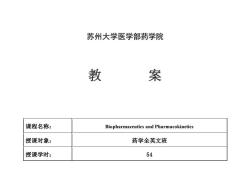
苏州大学医学部药学院 教 案 课程名称: Biopharmaceutics and Pharmacokinetics 授课对象: 药学全英文班 授课学时: 54
苏州大学医学部药学院 教 案 课程名称: Biopharmaceutics and Pharmacokinetics 授课对象: 药学全英文班 授课学时: 54
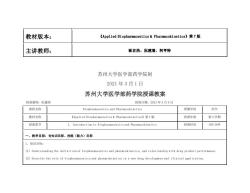
教材版本: 《Applied Biopharmaceutics&Pharmacokinetics?》第7版 主讲教师: 崔京浩,阮建清,柯亨特 苏州大学医学部药学院制 2021年3月1日 苏州大学医学部药学院授课教案 授课教师:阮建清 授课日期:2021年3月4日 课程名称 Biopharmaceutics and Pharmacokinetics 所属学科 药学 教材名称 《Applied Biopharmaceutics&Pharmacokinetics》第7版 授课年级 第六学期 授课章节 1.Introduction to Biopharmaceutics and Pharmacokinetics 授课时间 100分钟 一、敕学目标:含知识目标、技能(能力)目标 1.知识目标: (1)Understanding the definition of biopharmaceutics and pharmcokinetics,and relationship with drug product performance. (2)Describe the role of biopharmaceutics and pharmcokinetics in a new drug development and clinical application
教材版本: 《Applied Biopharmaceutics & Pharmacokinetics》第 7 版 主讲教师: 崔京浩,阮建清,柯亨特 苏州大学医学部药学院制 2021 年 3 月 1 日 苏州大学医学部药学院授课教案 授课教师:阮建清 授课日期:2021 年 3 月 4 日 课程名称 Biopharmaceutics and Pharmacokinetics 所属学科 药学 教材名称 《Applied Biopharmaceutics & Pharmacokinetics》第 7 版 授课年级 第六学期 授课章节 1. Introduction to Biopharmaceutics and Pharmacokinetics 授课时间 100 分钟 一、教学目标:含知识目标、技能(能力)目标 1.知识目标: (1) Understanding the definition of biopharmaceutics and pharmcokinetics, and relationship with drug product performance. (2) Describe the role of biopharmaceutics and pharmcokinetics in a new drug development and clinical application
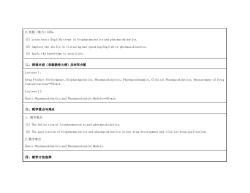
2.技能(能力)目标: (1)Learn basic English terms in biopharmaceutics and pharmacokinetics. (2)Improve the skills in listening and speaking English in pharmacokinetics. (3)Apply the knowledge to practices. 二、授课内容(依据教学大纲)及时间分配 Lecture I: Drug Product Performance,Biopharmaceutics,Pharmacokinetics,Pharmacodynamics,Clinical Pharmacokinetics,Measurement of Drug Concentrations-50 min Lecture II: Basic Pharmacokinetics and Pharmacokinetic Models-50 min 三、教学重点与难点 1.教学重点 (1)The definition of biopharmaceutics and pharmacokinetics. (2)The application of biopharmaceutics and pharmacokinetics in new drug development and clinical drug application. 2.教学难点 Basic Pharmacokinetics and Pharmacokinetic Models. 四、教学方法选择
2.技能(能力)目标: (1) Learn basic English terms in biopharmaceutics and pharmacokinetics. (2) Improve the skills in listening and speaking English in pharmacokinetics. (3) Apply the knowledge to practices. 二、授课内容(依据教学大纲)及时间分配 Lecture I: Drug Product Performance, Biopharmaceutics, Pharmacokinetics, Pharmacodynamics, Clinical Pharmacokinetics, Measurement of Dru g Concentrations—50 min Lecture II: Basic Pharmacokinetics and Pharmacokinetic Models—50 min 三、教学重点与难点 1.教学重点 (1) The definition of biopharmaceutics and pharmacokinetics. (2) The application of biopharmaceutics and pharmacokinetics in new drug development and clinical drug application. 2.教学难点 Basic Pharmacokinetics and Pharmacokinetic Models. 四、教学方法选择
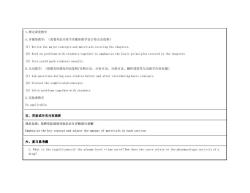
1.理论课堂教学 A.多媒体教学:(简要列出本章节多媒体教学设计特点及优势) (1)Review the major concepts and materials covering the chapters. (2)Work on problems with students together to emphasize the basic principles covered in the chapters (3)Test could push students usually. B.互动教学:(根据实际情况列出案例/实例讨论、分析讨论、分组讨论、翻转课堂等互动教学内容标题) (1)Ask questions during case studies before and after introducing basic concepts (2)Discuss the complicated concepts (3)Solve problems together with students 2.实验课教学 No applicable. 五、更新或补充内容提要 课后总结:按照实际进度对知识点分详略进行讲解 Emphasize the key concept and adjust the amount of materials in each section 六大、复习思考题 1.What is the significance of the plasma level-time curve?How does the curve relate to the pharmacologic activity of a drug?
1.理论课堂教学 A.多媒体教学:(简要列出本章节多媒体教学设计特点及优势) (1) Review the major concepts and materials covering the chapters. (2) Work on problems with students together to emphasize the basic principles covered in the chapters (3) Test could push students usually. B.互动教学:(根据实际情况列出案例/实例讨论、分析讨论、分组讨论、翻转课堂等互动教学内容标题) (1) Ask questions during case studies before and after introducing basic concepts (2) Discuss the complicated concepts (3) Solve problems together with students 2.实验课教学 No applicable. 五、更新或补充内容提要 课后总结:按照实际进度对知识点分详略进行讲解 Emphasize the key concept and adjust the amount of materials in each section 六、复习思考题 1. What is the significance of the plasma level–time curve? How does the curve relate to the pharmacologic activity of a drug?
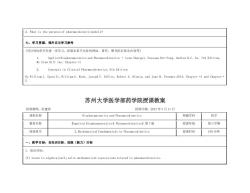
2.What is the purpose of pharmacokinetic models? 七、学习资源、课外自主学习参考 (可以列出供学生进一步学习、拓展本章节内容的网站、著作、期刊的名称及内容等) 1. Applied Biopharmaceutics and Pharmacokinetics Leon Shargel,Sussana Wu-Pong,Andrew B.C.Yu,7th Edition, Mc Graw Hill Inc:Chapter -1 2. Concepts in Clinical Pharmacokinetics,6th Edition By William J.Spruill,William E.Wade,Joseph T.DiPiro,Robert A.Blouin,and Jane M.Pruemer 2014:Chapter -1 and Chapter- 苏州大学医学部药学院授课教案 授课教师:阮建清 授课日期:2021年3月11日 课程名称 Biopharmaceutics and Pharmacokinetics 所属学科 药学 教材名称 《Applied Biopharmaceutics&Pharmacokinetics》第7版 授课年级 第六学期 授课章节 2.Mathematical Fundamentals in Pharmacokinetics 授课时间 100分钟 一、教学目标:含知识目标、技能(能力)目标 1.知识目标: (1)Learn to algebraically solve mathematical expressions related to pharmacokinetics
2. What is the purpose of pharmacokinetic models? 七、学习资源、课外自主学习参考 (可以列出供学生进一步学习、拓展本章节内容的网站、著作、期刊的名称及内容等) 1. Applied Biopharmaceutics and Pharmacokinetics – Leon Shargel, Sussana Wu- Pong, Andrew B.C. Yu, 7th Edition, Mc Graw Hill Inc; Chapter -1 2. Concepts in Clinical Pharmacokinetics, 6th Edition By William J. Spruill, William E. Wade, Joseph T. DiPiro, Robert A. Blouin, and Jane M. Pruemer 2014; Chapter -1 and Chapter - 2 苏州大学医学部药学院授课教案 授课教师:阮建清 授课日期:2021 年 3 月 11 日 课程名称 Biopharmaceutics and Pharmacokinetics 所属学科 药学 教材名称 《Applied Biopharmaceutics & Pharmacokinetics》第 7 版 授课年级 第六学期 授课章节 2.Mathematical Fundamentals in Pharmacokinetics 授课时间 100 分钟 一、教学目标:含知识目标、技能(能力)目标 1.知识目标: (1) Learn to algebraically solve mathematical expressions related to pharmacokinetics
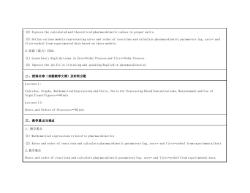
(2)Express the calculated and theoretical pharmacokinetic values in proper units. (3)Define various models representing rates and order of reactions and calculate pharmacokinetic parameters (eg,zero-and first-order)from experimental data based on these models. 2.技能(能力)目标: (1)Learn basic English terms in Zero-Order Process and First-Order Process (2)Improve the skills in listening and speaking English in pharmacokinetics 二、授课内容(依据款学大纲)及时间分配 Lecture I: Calculus,Graphs,Mathematical Expressions and Units,Units for Expressing Blood Concentrations,Measurement and Use of Significant Figures-50 min Lecture II: Rates and Orders of Processes-50 min 三、教学重点与难点 1.教学重点 (1)Mathematical expressions related to pharmacokinetics (2)Rates and order of reactions and calculate pharmacokinetic parameters (eg,zero-and first-order)from experimental data 2.教学难点 Rates and order of reactions and calculate pharmacokinetic parameters (eg,zero-and first-order)from experimental data
(2) Express the calculated and theoretical pharmacokinetic values in proper units. (3) Define various models representing rates and order of reactions and calculate pharmacokinetic parameters (eg, zero - and first-order) from experimental data based on these models. 2.技能(能力)目标: (1) Learn basic English terms in Zero-Order Process and First-Order Process (2) Improve the skills in listening and speaking English in pharmacokinetics 二、授课内容(依据教学大纲)及时间分配 Lecture I: Calculus, Graphs, Mathematical Expressions and Units, Units for Expressing Blood Concentrations, Measurement and Use of Significant Figures—50 min Lecture II: Rates and Orders of Processes—50 min 三、教学重点与难点 1.教学重点 (1) Mathematical expressions related to pharmacokinetics (2) Rates and order of reactions and calculate pharmacokinetic parameters (eg, zero - and first-order) from experimental data 2.教学难点 Rates and order of reactions and calculate pharmacokinetic parameters (eg, zero- and first-order) from experimental data
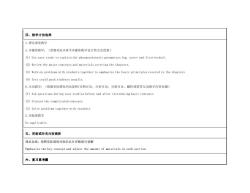
四、教学方法选择 1.理论课堂教学 A.多媒体教学:(简要列出本章节多媒体教学设计特点及优势) (1)Use case study to explain the pharmacokinetic parameters (eg,zero-and first-order). (2)Review the major concepts and materials covering the chapters. (3)Work on problems with students together to emphasize the basic principles covered in the chapters (4)Test could push students usually. B.互动教学:(根据实际情况列出案例/实例讨论、分析讨论、分组讨论、翻转课堂等互动教学内容标题) (1)Ask questions during case studies before and after introducing basic concepts (2)Discuss the complicated concepts (3)Solve problems together with students 2.实验课教学 No applicable. 五、更新或补充内容提要 课后总结:按照实际进度对知识点分详略进行讲解 Emphasize the key concept and adjust the amount of materials in each section 六、复习思考愿
四、教学方法选择 1.理论课堂教学 A.多媒体教学:(简要列出本章节多媒体教学设计特点及优势) (1) Use case study to explain the pharmacokinetic parameters (eg, zero - and first-order). (2) Review the major concepts and materials covering the chapters. (3) Work on problems with students together to emphasize the basic principles covered in the chapters (4) Test could push students usually. B.互动教学:(根据实际情况列出案例/实例讨论、分析讨论、分组讨论、翻转课堂等互动教学内容标题) (1) Ask questions during case studies before and after introducing basic concepts (2) Discuss the complicated concepts (3) Solve problems together with students 2.实验课教学 No applicable. 五、更新或补充内容提要 课后总结:按照实际进度对知识点分详略进行讲解 Emphasize the key concept and adjust the amount of materials in each section 六、复习思考题
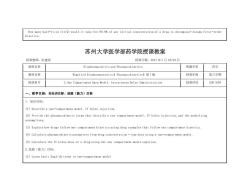
How many half-lives (t1/2)would it take for 99.9%of any initial concentration of a drug to decompose?Assume first-order kinetics. 苏州大学医学部药学院授课教案 授课教师:阮建清 授课日期:2021年3月18/25日 课程名称 Biopharmaceutics and Pharmacokinetics 所属学科 药学 教材名称 《Applied Biopharmaceutics&Pharmacokinetics》第7版 授课年级 第六学期 授课章节 3.One Compartment Open Model:Intravenous Bolus Administration 授课时间 200分钟 一、教学目标:含知识目标、技能(能力)目标 1.知识目标: (1)Describe a one-compartment model,IV bolus injection. (2)Provide the pharmacokinetic terms that describe a one compartment model,IV bolus injection,and the underlying assumptions. (3)Explain how drugs follow one compartment kinetics using drug examples that follow one compartment kinetics. (4)Calculate pharmacokinetic parameters from drug concentration-time data using a one-compartment model. (5)Calculate the IV bolus dose of a drug using the one compartment model equation. 2.技能(能力)目标: (1)Learn basic English terms in one-compartment model
How many half-lives (t1/2) would it take for 99.9% of any initial concentration of a drug to decompose? Assume first -order kinetics. 苏州大学医学部药学院授课教案 授课教师:阮建清 授课日期:2021 年 3 月 18/25 日 课程名称 Biopharmaceutics and Pharmacokinetics 所属学科 药学 教材名称 《Applied Biopharmaceutics & Pharmacokinetics》第 7 版 授课年级 第六学期 授课章节 3.One Compartment Open Model: Intravenous Bolus Administration 授课时间 200 分钟 一、教学目标:含知识目标、技能(能力)目标 1.知识目标: (1) Describe a one-compartment model, IV bolus injection. (2) Provide the pharmacokinetic terms that describe a one compartment model, IV bolus injection, and the underlying assumptions. (3) Explain how drugs follow one compartment kinetics using drug examples that follow one compartment kinetics. (4) Calculate pharmacokinetic parameters from drug concentration–time data using a one-compartment model. (5) Calculate the IV bolus dose of a drug using the one compartment model equation. 2.技能(能力)目标: (1) Learn basic English terms in one-compartment model
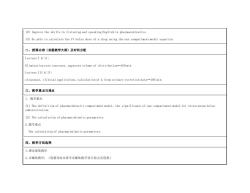
(2)Improve the skills in listening and speaking English in pharmacokinetics (3)Be able to calculate the IV bolus dose of a drug using the one compartment model equation 二、授课内容(依据教学大纲)及时间分配 Lecture I II: Elimination rate constant,apparent volume of distribution-100 min Lecture III IV: clearance,clinical application,calculation of k from urinary excretion data-100 min 三、教学重点与难点 1.教学重点 (1)The definition of pharmacokinetic compartment model,the significance of one compartment model for intravenous bolus administration. (2)The calculation of pharmacokinetic parameters. 2.教学难点 The calculation of pharmacokinetic parameters. 四、教学方法选择 1.理论课堂教学 A.多媒体教学:(简要列出本章节多媒体教学设计特点及优势)
(2) Improve the skills in listening and speaking English in pharmacokinetics (3) Be able to calculate the IV bolus dose of a drug using the one compartment model equation 二、授课内容(依据教学大纲)及时间分配 Lecture I & II: Elimination rate constant, apparent volume of distribution—100 min Lecture III & IV: clearance, clinical application, calculation of k from urinary excretion data—100 min 三、教学重点与难点 1.教学重点 (1) The definition of pharmacokinetic compartment model, the significance of one compartment model for intravenous bolus administration. (2) The calculation of pharmacokinetic parameters. 2.教学难点 The calculation of pharmacokinetic parameters. 四、教学方法选择 1.理论课堂教学 A.多媒体教学:(简要列出本章节多媒体教学设计特点及优势)
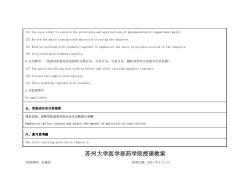
(1)Use case study to explain the principles and applications of pharmacokinetic compartment model (2)Review the major concepts and materials covering the chapters. (3)Work on problems with students together to emphasize the basic principles covered in the chapters (4)Test could push students usually. B.互动教学:(根据实际情况列出案例/实例讨论、分析讨论、分组讨论、翻转课堂等互动教学内容标题) (1)Ask questions during case studies before and after introducing basic concepts (2)Discuss the complicated concepts (3)Solve problems together with students 2.实验课教学 No applicable. 五、更新或补充内容提要 课后总结:按照实际进度对知识点分详略进行讲解 Emphasize the key concept and adjust the amount of materials in each section 六、复习思考题 The first learning question in chapter 3. 苏州大学医学部药学院授课教案 授课教师:阮建清 授课日期:2021年4月1日
(1) Use case study to explain the principles and applications of pharmacokinetic compartment model (2) Review the major concepts and materials covering the chapters. (3) Work on problems with students together to emphasize the basic principles covered in the chapters (4) Test could push students usually. B.互动教学:(根据实际情况列出案例/实例讨论、分析讨论、分组讨论、翻转课堂等互动教学内容标题) (1) Ask questions during case studies before and after introducing basic concepts (2) Discuss the complicated concepts (3) Solve problems together with students 2.实验课教学 No applicable. 五、更新或补充内容提要 课后总结:按照实际进度对知识点分详略进行讲解 Emphasize the key concept and adjust the amount of materials in each section 六、复习思考题 The first learning question in chapter 3. 苏州大学医学部药学院授课教案 授课教师:阮建清 授课日期:2021 年 4 月 1 日
按次数下载不扣除下载券;
注册用户24小时内重复下载只扣除一次;
顺序:VIP每日次数-->可用次数-->下载券;
- 苏州大学医学部药学院:专业必修课程《药剂学与药物动力学 Biopharmaceutics and Pharmacokinetics》课程教学资源(教学大纲).docx
- 苏州大学医学部药学院:专业必修课程《生物药剂学与药物动力学实验 Biopharmaceutics and pharmacokinetic experiments》课程教学资源(教学大纲).docx
- 苏州大学医学部药学院:专业必修课程《天然药物化学 Natural Medicinal Chemistry》课程教学资源(教学大纲).docx
- 苏州大学医学部药学院:专业必修课程《药用植物学与生药学 Pharmaceutical Botany &Pharmacognosy》课程教学资源(电子教案).docx
- 苏州大学医学部药学院:专业必修课程《药用植物学与生药学 Pharmaceutical Botany &Pharmacognosy》课程教学资源(教学大纲).docx
- 苏州大学医学部药学院:专业核心课程《药物分析(一)Pharmaceutical Analysis I》课程教学资源(电子教案).docx
- 苏州大学医学部药学院:专业核心课程《药物分析(一)Pharmaceutical Analysis I》课程教学资源(教学大纲).docx
- 苏州大学医学部药学院:专业核心课程《药物化学 Medicinal Chemistry》课程教学资源(电子教案).pdf
- 苏州大学医学部药学院:专业核心课程《药物化学 Medicinal Chemistry》课程教学资源(教学大纲).docx
- 苏州大学医学部药学院:专业核心课程《药剂学 Pharmaceutics》课程教学资源(电子教案).docx
- 苏州大学医学部药学院:专业核心课程《药剂学 Pharmaceutics》课程教学资源(教学大纲).docx
- 苏州大学医学部药学院:专业核心课程《药理学(四)Pharmacology IV》课程教学资源(电子教案).docx
- 苏州大学医学部药学院:专业核心课程《药理学(四)Pharmacology IV》课程教学资源(教学大纲).docx
- 苏州大学医学部药学院:专业核心课程《药事管理学》课程教学资源(电子教案).pdf
- 苏州大学医学部药学院:专业核心课程《药物化学实验》课程教学资源(电子教案).docx
- 苏州大学医学部药学院:专业核心课程《药物化学实验 Medicinal Chemistry Experiments》课程教学资源(教学大纲).docx
- 苏州大学医学部药学院:专业核心课程《药剂学实验 Pharmaceutics experiment》课程教学资源(电子教案).docx
- 苏州大学医学部药学院:专业核心课程《药剂学实验 Pharmaceutics experiment》课程教学资源(教学大纲).docx
- 苏州大学医学部药学院:专业核心课程《药理学(四)实验》课程教学资源(电子教案).docx
- 苏州大学医学部药学院:专业核心课程《药理学实验 Pharmacology Experiments》课程教学资源(教学大纲).docx
- 苏州大学医学部药学院:专业必修课程《药物合成 Drug Synthesis》课程教学资源(教学大纲).docx
- 苏州大学医学部药学院:专业必修课程《药物合成 Drug Synthesis》课程教学资源(电子教案).docx
- 苏州大学医学部药学院:专业必修课程《学科综合训练 Comprehensive Discipline Training》课程教学资源(教学大纲).docx
- 苏州大学医学部药学院:大类基础课程《微生物与免疫学实验 Microbiology & Immunology Experiments》课程教学资源(教学大纲).docx
- 苏州大学医学部药学院:大类基础课程《微生物与免疫学实验 Microbiology & Immunology Experiments》课程教学资源(电子教案).docx
- 苏州大学医学部药学院:大类基础课程《细胞与分子生物学实验 Cellular and Molecular Biology Experiment》课程教学资源(教学大纲).docx
- 苏州大学医学部药学院:大类基础课程《细胞与分子生物学实验 Cellular and Molecular Biology Experiment》课程教学资源(电子教案).pdf
- 苏州大学医学部药学院:大类基础课程《物理化学 Physical Chemistry》课程教学资源(教学大纲).docx
- 苏州大学医学部药学院:大类基础课程《物理化学 Physical Chemistry》课程教学资源(电子教案).docx
- 苏州大学医学部药学院:大类基础课程《有机化学 Organic Chemistry》课程教学资源(教学大纲).docx
- 苏州大学医学部药学院:大类基础课程《有机化学 Organic Chemistry》课程教学资源(电子教案).docx
- 苏州大学医学部药学院:大类基础课程《分析化学 Analytical Chemistry》课程教学资源(教学大纲).docx
- 苏州大学医学部药学院:大类基础课程《分析化学 Analytical Chemistry》课程教学资源(电子教案).docx
- 苏州大学医学部药学院:大类基础课程《无机化学 Inorganic Chemistry》课程教学资源(教学大纲).docx
- 苏州大学医学部药学院:大类基础课程《无机化学 Inorganic Chemistry》课程教学资源(电子教案).docx
- 苏州大学医学部药学院:大类基础课程《免疫学及微生物学 Microbiology & Immunology》课程教学资源(教学大纲).pdf
- 苏州大学医学部药学院:大类基础课程《免疫学及微生物学 Microbiology & Immunology》课程教学资源(电子教案).docx
- 苏州大学医学部药学院:大类基础课程《分子细胞生物学 Molecular cell Biology》课程教学资源(教学大纲).docx
- 苏州大学医学部药学院:大类基础课程《分子细胞生物学 Molecular cell Biology》课程教学资源(授课教案).pdf
- 苏州大学医学部药学院:大类基础课程《生物化学 Biochemistry V》课程教学资源(教学大纲).pdf
